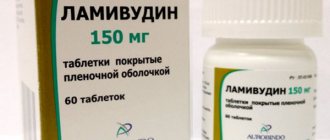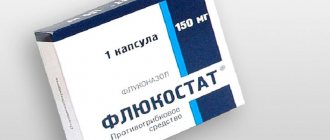Disaverox tab.p.p.o. 300mg+150mg No. 60 199043
Description
Pharmacological group Antiviral [HIV] agent. Pharmacodynamics Antiviral combination drug. Lamivudine and zidovudine are highly effective selective inhibitors of HIV-1 and HIV-2. Lamivudine is a synergist with zidovudine in inhibiting HIV replication: Both components of the drug are sequentially metabolized by intracellular kinases to triphosphate derivatives. Lamivudine triphosphate and zidovudine triphosphate are substrates for HIV reverse transcriptase and competitive inhibitors of this enzyme. However, the antiviral activity of lamivudine and zidovudine is primarily due to the inclusion of their monophosphate form in the viral DNA chain, resulting in chain breakage. Triphosphates of lamivudine and zidovudine have significantly lower affinity for DNA polymerases of human cells. Combination therapy with lamivudine and zidovudine slows the development of resistance to zidovudine in patients who have not previously received antiretroviral therapy. Lamivudine in combination with zidovudine reduces viral load and increases the number of CD 4+ cells. Combination therapy with lamivudine and zidovudine reduces the risk of disease progression and death. Pharmacokinetics: Well absorbed from the gastrointestinal tract (in adults, the bioavailability of lamivudine is 80-85%, zidovudine is 60-70%). Both components of the drug bind weakly to plasma proteins. Penetrates the central nervous system and cerebrospinal fluid. Lamivudine is excreted from the body primarily unchanged by the kidneys. The half-life (T½) is 5-7 hours. Zidovudine is metabolized in the liver, where conjugation with glucuronic acid occurs. It is excreted by the kidneys mainly in the form of glucuronide. T½ of zidovudine is about 1 hour. Special groups of patients Elderly patients: pharmacokinetics have not been studied in patients over 65 years of age. Children: in children over 5-6 months of age, the pharmacokinetic parameters of zidovudine are similar to those in adults. Zidovudine is well absorbed from the intestine after administration at all dosages studied in adults and children; its bioavailability is 64-70%, on average 65%. The maximum concentration at steady state is 4.45 μM (1.19 μg/ml) after taking 120 mg/m2 of zidovudine in solution form and 7.7 μM (2.06 μg/ml) after taking a dose of 180 mg/m2. A dose of 180 mg/m2 4 times a day leads to the same systemic exposure in children (the area under the concentration-time curve from 0 to 24 hours after dosing (AUC 24) is 10.7 μg/ml) as 200 mg 6 times a day in adults (AUC 24 10.9x mcg/ml). In general, the pharmacokinetics of lamivudine in children are similar to those in adult patients. However, absolute bioavailability (approximately 55-56%) was reduced in children under 12 years of age. Systemic clearance in children is higher than in adults and tends to decrease as they grow older, reaching levels similar to adults by 12 years. Taking these differences into account, the recommended dose of lamivudine in children (aged 3 months to 12 years, weighing 6 kg to 40 kg) is 8 mg/kg/day. After taking this dose, AUC 0-12 reaches 3800 - 5300 nghch/ml. Recent evidence suggests that exposure in children aged 2 to 6 years may be reduced by 30% compared with other age groups. Patients with impaired renal function: Due to decreased renal clearance, the elimination of lamivudine is impaired in renal failure. A dose reduction of lamivudine is recommended in patients with a creatine clearance of 50 ml/min. Plasma concentrations of zidovudine are also increased in patients with severe renal impairment. Liver impairment: Decreased glucuronidation in patients with impaired liver function due to cirrhosis may result in accumulation of zidovudine. Dose adjustments are required in patients with severe renal impairment. Pregnancy: Pregnancy does not affect the pharmacokinetics of lamivudine and zidovudine. Lamivudine and zidovudine are found in the serum of the child at birth in the same concentrations as in the serum of the mother and umbilical cord blood at birth, which supports the theory of passive penetration of the blood-placental barrier. Indications HIV infection in children over 12 years of age and adults with progressive immunodeficiency (the number of C D 4+ cells is less than 500/μl). Contraindications Hypersensitivity to zidovudine and lamivudine and to other components of the drug, neutrophil count (less than 750/μl), anemia (hemoglobin less than 7.5 g/dl or 4.65 mmol/l), children under 12 years of age and body weight less than 30 kg, lactation period. With caution Hepatomegaly, hepatitis, liver cirrhosis, obesity, risk factors predisposing to liver damage. Use during pregnancy and lactation Disaverox can be prescribed to pregnant women only in cases where the expected benefit to the mother outweighs the possible risk to the fetus. Women who take the drug are not recommended to breastfeed. Side effects The adverse reactions described below were observed when treating HIV infection with lamivudine and zidovudine as monotherapy or as a combination of these drugs. For many adverse reactions, it is unclear whether they are caused by lamivudine, zidovudine, a wide range of other drugs used to treat HIV infection, or are complications of HIV infection itself. Disaverox contains lamivudine and zidovudine and may cause side effects that are specific to each of these components. There is currently no evidence that the combination of lamivudine and zidovudine has additive toxicity. The following classification of adverse reactions was used depending on the frequency of occurrence: very often (≥1/10), often (≥1/100 or <1/10), infrequently (≥1/1000 and <1/100), rarely (≥1 /10000 and <1/1000), very rarely (<1/10000 including isolated cases). Lamivudine From the hematopoietic and lymphatic system: Uncommon: neutropenia, anemia, thrombocytopenia. Rare: true erythrocyte aplasia. Metabolism and nutrition: Often: hyperlactatemia. Rarely: lactic acidosis. From the nervous system: often: headache. Rarely: paresthesia, peripheral neuropathy. From the gastrointestinal tract: Often: nausea, vomiting, epigastric pain, diarrhea. Rarely: pancreatitis, increased amylase activity in the blood serum. From the liver and biliary tract Uncommon: transient increase in the activity of liver enzymes (alanine aminotransferase (ALT), aspartate aminotransferase (AST). Rarely: hepatitis. From the skin and subcutaneous tissue: rash, alopecia. From the musculoskeletal system and connective tissue Common: arthralgia, muscle disorders Rare: rhabdomyolysis Other: fatigue, fever, general malaise, redistribution/accumulation of subcutaneous fat Zidovudine From the hematopoietic and lymphatic system: Common: anemia (blood transfusion may be required), neutropenia and leukopenia. Uncommon: thrombocytopenia and pancytopenia (with bone marrow hypoplasia) Rare: true erythrocyte aplasia Very rare: aplastic anemia Metabolic and nutritional disorders: Common: hyperlactatemia Rare: lactic acidosis, anorexia Mental disorders: Rare: anxiety, depression From the nervous system: Very often: headache. Common: dizziness. Rarely: insomnia, paresthesia, drowsiness, decreased mental activity, convulsions, confusion. From the cardiovascular system: Rarely: cardiomyopathy. From the respiratory system, chest and mediastinal organs: Uncommon: shortness of breath. Rarely: rhinitis, sinusitis, cough. From the gastrointestinal tract: Often: nausea, vomiting, stomach pain, diarrhea. Uncommon: flatulence. Rarely: pigmentation of the oral mucosa, taste perversion, dyspepsia, pancreatitis. From the liver and biliary tract: Often: increased activity of liver enzymes and bilirubin concentration. Rare: liver damage such as severe hepatomegaly with stenosis. From the skin and subcutaneous tissue: Uncommon: rash and itching. Rarely: pigmentation of nails and skin, urticaria and increased sweating. WITH
Compound
Active ingredient: Zidovudine 300 mg, Lamivudine 150 mg Excipients: Each film-coated tablet contains: Core: sodium carboxymethyl starch (Primogel) - 22.5 mg, pregelatinized starch - 22.5 mg, colloidal silicon dioxide (Aerosil grade A -300) - 2.5 mg, magnesium stearate - 4.5 mg, microcrystalline cellulose - 78.0 mg. Film coating: ready-made water-soluble film coating - 15.0 mg. (Shell composition: hydroxypropyl methylcellulose (hypromellose) - 25.0%, copovidone (copolyvidone) - 22.5%, polyethylene glycol 6000 (macrogol 6000) - 9.5%, glyceryl caprylocaprate - 3.0%, polydextrose - 15.0% , titanium dioxide - 25.0%).
Application
Orally, regardless of food intake, for adults and children over 12 years of age and weighing at least 30 kg, 1 tablet 2 times a day. In case of chronic renal failure (with creatinine clearance less than 50 ml/min), liver failure, with hemoglobin concentration less than 9 g/dl or 5.59 mmol/l, neutropenia below 1 thousand/µl, it is necessary to use lamivudine and zidovudine in the form of separate drugs, to individually select the dose of lamivudine and zidovudine. Children weighing less than 30 kg Separate preparations of lamivudine and zidovudine should be used. Elderly patients: There are no specific data on the use of Disaverox in elderly patients. However, when treating elderly patients, special caution is recommended, taking into account age-related changes, such as changes in hematological parameters and renal dysfunction.
Composition, release form and packaging
| Film-coated tablets | 1 tab. |
| zidovudine | 300 mg |
| lamivudine | 150 mg |
10 pieces. – contour cell packaging (2) – cardboard packs. 10 pcs. – contour cell packaging (3) – cardboard packs. 10 pcs. – contour cell packaging (6) – cardboard packs. 10 pcs. – contour cell packaging (10) – cardboard packs. 60 pcs. – cans (1) – cardboard packs. 100 pcs. – cans (1) – cardboard packs.
pharmachologic effect
Antiviral combination agent. Lamivudine and zidovudium are highly effective selective inhibitors of HIV-1 and HIV-2. Lamivudine is a synergist with zidovudine in inhibiting HIV replication. Both components of the drug are sequentially metabolized by intracellular kinases to triphosphate derivatives. Lamivudine triphosphate and zidovudine triphosphate are substrates for HIV reverse transcriptase and competitive inhibitors of this enzyme. However, the antiviral activity of lamivudine and zidovudine is primarily due to the inclusion of their monophosphate form in the viral DNA chain, resulting in chain breakage. Triphosphates of lamivudine and zidovudine have significantly lower affinity for DNA polymerases of human cells.
Combination therapy with lamivudine and zidovudine slows the development of resistance to zidovudine in patients who have not previously received antiretroviral therapy.
Lamivudine in combination with zidovudine reduces viral load and increases the number of CD4+ cells. Combination therapy with lamivudine and zidovudine reduces the risk of disease progression and death.
special instructions
If individual dose selection is necessary, it is recommended to take separate preparations of lamivudine and zidovudine. Physicians should refer to information on the use of these drugs.
Despite taking Disaverox or any other antiretroviral drug, patients may develop opportunistic infections and other complications of HIV infection. Therefore, patients should be under constant supervision of doctors experienced in treating HIV infection.
Patients should be informed that treatment with antiretroviral drugs such as Disaverox prevents the risk of transmitting HIV to others through sexual contact or transfusion of infected blood, so patients should take appropriate precautions.
It is necessary to warn patients about the possible interaction of the drug Disaverox with other drugs when taken concomitantly.
Hematological disorders
Anemia, neutropenia and leukopenia (the latter usually secondary to neutropenia) may develop in patients receiving zidovudium. These phenomena are more often observed when high doses of zidovudine (1200-1500 mg/day) are prescribed in patients with advanced stages of HIV infection with reduced bone marrow reserve before treatment. Therefore, in patients receiving Disaverox, it is necessary to carefully monitor hematological parameters. These hematological changes usually appear no earlier than 4-6 weeks after the start of therapy. In patients with late-stage clinically significant HIV infection, it is recommended to monitor blood tests at least once every 2 weeks during the first three months of therapy, and then at least once a month.
In patients with early stage HIV infection, side effects from the blood system are rare. Blood tests can be done less frequently, based on the general condition of the patients, for example once every 1-3 months. Special titration of zidovudine may be required if severe anemia or myelosuppression develops during treatment with Disaverox, or in patients with pre-existing bone marrow suppression, such as hemoglobin concentration less than 9 g/dL (5.59 mmol/L) or neutrophil count less than 1. 0 × 10%. Since it is impossible to individually select the dose of Disavsrox, it is recommended to use separate preparations of lamivudine and zidovudine.
Pancreatitis
Cases of pancreatitis have been described in patients taking lamivudine and zidovudine. However, it has not been established whether this complication is caused by medications or the underlying disease - HIV infection. Treatment with Disaverox should be stopped immediately if clinical symptoms or laboratory data indicating the development of pancreatitis (abdominal pain, nausea, vomiting or increased values of biochemical markers) appear.
Osteonecrosis
Although the etiology of osteonecrosis is considered multifactorial (eg, glucocorticosteroid use, alcohol consumption, acute immunosuppression, increased body mass index play an important role in the development of this complication), such cases have been reported particularly in patients with advanced HIV infection/or those receiving long-term antiretroviral therapy. therapy. Patients should consult their healthcare provider if they experience symptoms such as lethargy, stiffness, joint pain, or difficulty moving.
Lactic acidosis/severe hepatomegaly with steatosis
Rare, but possibly fatal, cases of lactic acidosis and severe hepatomegaly with fatty liver have been described in patients taking antiretroviral drugs - nucleoside analogues, as monotherapy or in combination, including lamivudine and zidovudine. Most cases were reported in women.
Clinical symptoms of lactic acidosis include general weakness, loss of appetite and sudden unexplained weight loss, gastrointestinal and respiratory problems (shortness of breath and rapid breathing).
Disaverox should be used with caution in patients with risk factors for liver damage. The drug should be suspended in patients with clinical and laboratory symptoms of lactic acidosis or hepatotoxicity (including hepatomegaly and steatosis, even in the absence of increased traisaminase activity).
Redistribution of subcutaneous fiber
Some patients receiving combination antiretroviral therapy experience redistribution/accumulation of adipose tissue, including central obesity, dorsovisceral fat deposition (“buffalo hump”), loss of limbs and face, enlarged mammary glands, and increased serum lipid and glucose concentrations. Patients may experience these symptoms together or separately.
Although all protease inhibitor (PI) and nucleoside reverse transcriptase inhibitor (NRTI) classes of drugs may cause one or more of the above side effects associated with the common syndrome often referred to as lipodystrophy, evidence suggests that differences exist among individual members of these classes. drugs are capable of causing side effects.
It should also be noted that lipodystrophy syndrome has a multifactorial etiology; for example, stage of HIV infection, advanced age, and duration of antiretroviral therapy play an important, possibly synergistic role.
The long-term consequences of these side effects are currently unknown.
Clinical examination of patients should include assessment of physical signs of redistribution of adipose tissue. Serum lipid and glucose concentrations should be determined. Lipid metabolism disorders must be treated based on their clinical manifestations.
Mitochondrial dysfunction
In vitro and in vivo conditions have revealed the ability of nucleotide and nucleoside analogues to cause mitochondrial damage to varying degrees. There are reports of mitochondrial dysfunction in HIV-negative children exposed to nucleoside analogues in utero or immediately after birth. The main manifestations of mitochondrial dysfunction, often transient, were anemia, neutropenia, hyperlactatemia and increased plasma lipase activity. Later manifestations of this disorder were also noted: muscle hypertonicity, convulsions, behavioral abnormalities.
Immune reconstitution syndrome
At the beginning of treatment with antiretroviral drugs in HIV-infected patients with severe immunodeficiency, an exacerbation of the inflammatory process against the background of an asymptomatic or residual opportunistic infection is possible, which can cause a serious deterioration of the condition or aggravation of symptoms. Typically, such reactions are observed during the first weeks or months after starting antiretroviral therapy. The most significant examples are cytomegalovirus retinitis, generalized and/or focal mycobacterial infection and Pneumocystis pneumonia. Any symptoms of inflammation must be immediately identified and treatment initiated if necessary. Autoimmune diseases (such as Graves' disease, polymyositis and Guillain-Barre syndrome) have been observed in the setting of immune reconstitution, but the timing of initial manifestations varies and the disease may occur many months after the start of therapy and have an atypical course.
Patients with liver disease
In patients with previously diagnosed liver diseases (including chronic hepatitis), the incidence of liver dysfunction increases when using combination antiretroviral therapy. The drug Disaverox should be used with caution in this category of patients. Patients should be closely monitored; If signs of deterioration in liver function appear, discontinuation of therapy should be considered.
Patients with chronic hepatitis B or C
The risk of hepatotoxicity from antiretroviral drugs in patients co-infected with HIV and hepatitis B or C virus is higher than in patients with HIV infection alone. Therefore, patients with chronic hepatitis B or C who are concomitantly taking antiretroviral drugs are at increased risk of adverse liver effects, possibly fatal. Such patients should be closely monitored, both clinically and laboratory.
Concomitant viral hepatitis B
The drug Disaverox should be used with caution in patients. infected simultaneously with HIV and hepatitis B virus, since after cessation of therapy with lamivudn, clinical or laboratory signs of exacerbation of hepatitis may appear, which can have serious consequences in case of decompensation of liver function. After completion of therapy with Disaverox in patients infected with HIV and hepatitis B virus, it is necessary to monitor biochemical indicators of liver function and markers of hepatitis B virus replication.
Concomitant viral hepatitis C
Worsening of anemia was observed with the combined use of ribavirin and zidovudine, although the mechanism of development of this phenomenon remains unclear. Therefore, concomitant use of ribavirn and zidovudine is not recommended, especially in patients with a history of zidovudine-induced anemia. In extreme cases, it is recommended to consider the possibility of changing the antiretroviral therapy regimen in order to discontinue zidovudine.
Impact on the ability to drive vehicles and machinery
There have been no specific studies of the effect of lamivudine and zidovudine on the ability to drive and operate machinery. The pharmacological properties of these drugs indicate a low probability of such an effect. The clinical condition of the patient should be taken into account, as well as the nature of the side effects of lamivudine and zidovudine.
Overdose
Symptoms: no specific dose-dependent symptoms have been identified in acute overdose of lamivudine or zidovudine other than those listed in the Side Effects section.
Treatment: monitoring the patient's condition and standard supportive therapy, continuous hemodialysis is recommended.
Side effect
Since the drug Disaverox contains lamivudine and zidovudine, it can enter into any interactions characteristic of each of the components. The likelihood of metabolic interactions with lamivudne is low, since only a small part of the administered drug is metabolized and binds to plasma proteins, and the drug is almost completely excreted unchanged by the kidneys.
Zidovudine is also slightly bound to plasma proteins, but is eliminated primarily through hepatic metabolism to an inactive glucuronide.
Drugs with predominant hepatic metabolism, particularly via glucuronidation, may potentially inhibit the metabolism of zidovudine. Listed below are some drugs representing classes of drugs that should be used with caution during therapy with Disaverox.
Interactions involving lamivudine
Lamivudine is predominantly eliminated via the cationic transport system; therefore, one should be aware of the possibility of interaction between the drug Disaverox and drugs that have the same route of elimination.
Trimethoprim/sulfamethoxazole: Concomitant use of lamivudine and a combination of trimethoprim and sulfamethoxazole (160 mg + 800 mg, co-trimoxazole) leads to an increase in lamivudine plasma concentrations by 40% when taking this drug in therapeutic doses. However, patients with normal renal function do not require lamivudine dose adjustment. Lamivudine does not affect the pharmacokinetics of trimethoprim or sulfamethoxazole. Caution must be exercised when co-trimoxazole is used concomitantly with Disaverox in patients with renal failure. The effect of co-administration of lamivudine and high doses of co-trimoxazole for the treatment of pneumocystis pneumonia and toxoplasmosis has not been studied. Zalcitabine: Lamivudine may inhibit the intracellular phosphorylation of zalcitabine when administered concomitantly. Therefore, it is not recommended to use Disaverox in combination with zalcitabine.
Interactions involving zidovudine
Atovaquone: Zidovudine has no effect on the pharmacokinetics of atovaquone. However, pharmacokinetic data indicate that. that atovaquone reduces the degree of metabolism of zidovudine to its glucuronide (at steady state, the AUC of zidovudine increases by 33%, the maximum plasma concentration of glucuronide decreases by 19%). When zidovudine is prescribed in doses of 500-600 mg/day and a concomitant 3-week course of treatment of acute Pneumocystis pevonia with atovaquone, an increase in the frequency of adverse reactions associated with increased plasma concentrations of zidovudine is unlikely. If a longer combination of these drugs is necessary, careful monitoring of the patient's clinical condition is recommended.
Clarithromycin: Absorption of zidovudine is reduced when clarithromycin tablets are taken simultaneously. The interval between doses of zidovudine and clarithromycin should be at least 2 hours.
Lamivudine: Concomitant use of zidovudine and lamivudine results in a 13% increase in zidovudine exposure time and a 28% increase in its maximum plasma concentrations. However, the total zidovudine exposure (AUC) does not change significantly. Zidovudine does not affect the pharmacokinetics of lamivudine.
Phenytoin: Some patients receiving zidovudine in combination with phenytoin experienced a decrease in phenytoin blood concentrations, and in one case an increase in phenytoin concentrations. These observations indicate the need to monitor phenytoin blood concentrations in patients taking Disaverox and phenytoin concomitantly.
Probenecid: Probenecid has been reported to increase the mean half-life of zidovudine and AUC as a result of inhibition of glucuronide formation. In the presence of probenecid, renal excretion of glucuronide and, possibly, zidovudine itself is reduced.
Rifampicin: Limited data show that the combination of zidovudine and rifampicin reduced the AUC of zidovudine by 48 ± 34%. However, the clinical significance of this observation is unknown.
Stavudine: Zidovudine may inhibit the intracellular phosphorylation of stavudine when administered concomitantly. Thus, the combined use of stavudine and the drug Disaverox is not recommended.
Other drugs: acetylsalicylic acid, codeine, morphine, indomethacin, ketoprofen, paproxep, oxazepam, lorazepam, cimetidine, clofibrate, dapsone, isoprinazine can change the metabolism of zidovudine as a result of competitive inhibition of the formation of its glucuronide. Before prescribing these drugs in combination with the drug Disaverox. especially for long-term treatment, possible drug interactions must be assessed.
Combination with nephrotoxic and myelosuppressive drugs (peitamidine, dapsone, pyrimethamine, co-trimoxazole, amphotericin, flucytazine, ganciclovir, interferon, vincristine, vinblastine, doxorubicin) increases the likelihood of side effects of zidovudine. If Disaverox is co-administered with any of these drugs, renal function and hematological parameters should be carefully monitored and the dose of one or more drugs should be reduced if necessary.
Ribavirin blocks the antiviral activity of zidovudine.
To prevent opportunistic infections, co-trimoxazole, pentamidine in aerosol form, pyrimethamine and acyclovir are used. Limited clinical trial data indicate that there is no significant increase in the incidence of side effects of zidovudine when used concomitantly with these drugs.






